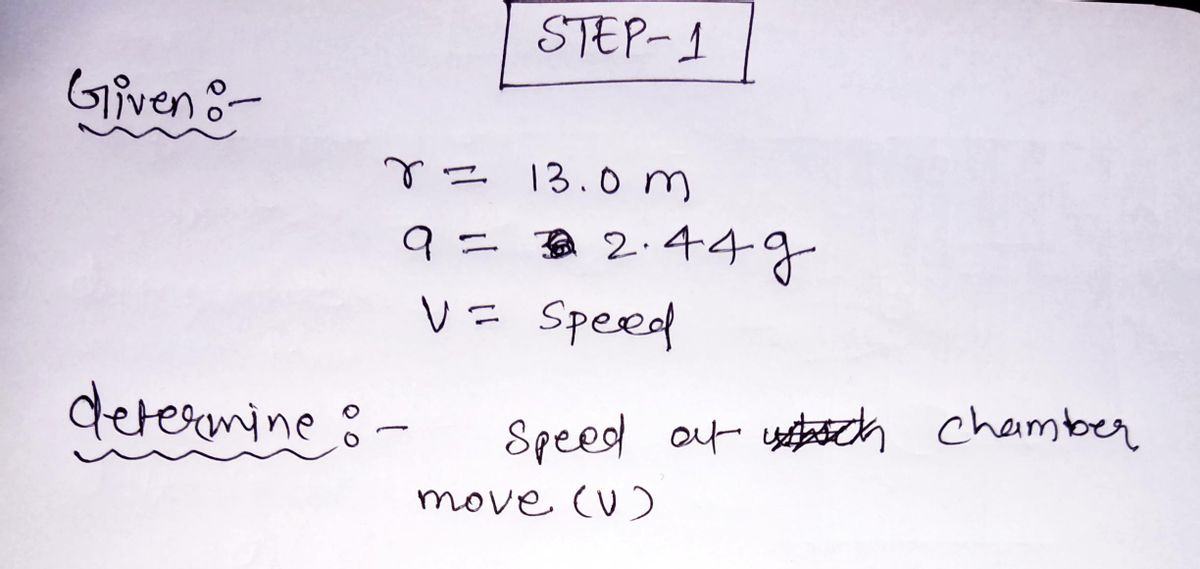The National Aeronautics and Space Administration (NASA) studies the physiological effects of large accelerations on astronauts. Some of these studies use a machine known as a centrifuge. This machine consists of a long arm, to one end of which is attached a chamber in which the astronaut sits. The other end of the arm is connected to an axis about which the arm and chamber can be rotated. The astronaut moves on a circular path, much like a model airplane flying in a circle on a guideline. The chamber is located 13.0 m from the center of the circle. At what speed must the chamber move so that an astronaut is subjected to 2.44 times the acceleration due to gravity? Number i Units
The National Aeronautics and Space Administration (NASA) studies the physiological effects of large accelerations on astronauts. Some of these studies use a machine known as a centrifuge. This machine consists of a long arm, to one end of which is attached a chamber in which the astronaut sits. The other end of the arm is connected to an axis about which the arm and chamber can be rotated. The astronaut moves on a circular path, much like a model airplane flying in a circle on a guideline. The chamber is located 13.0 m from the center of the circle. At what speed must the chamber move so that an astronaut is subjected to 2.44 times the acceleration due to gravity? Number i Units
Elements Of Electromagnetics
7th Edition
ISBN:9780190698614
Author:Sadiku, Matthew N. O.
Publisher:Sadiku, Matthew N. O.
ChapterMA: Math Assessment
Section: Chapter Questions
Problem 1.1MA
Related questions
Question

Transcribed Image Text:Current Attempt in Progress
The National Aeronautics and Space Administration (NASA) studies the physiological effects of large accelerations on astronauts.
Some of these studies use a machine known as a centrifuge. This machine consists of a long arm, to one end of which is attached a
chamber in which the astronaut sits. The other end of the arm is connected to an axis about which the arm and chamber can be
rotated. The astronaut moves on a circular path, much like a model airplane flying in a circle on a guideline. The chamber is located 13.0
m from the center of the circle. At what speed must the chamber move so that an astronaut is subjected to 2.44 times the acceleration
due to gravity?
Number
Units
e here to search
L H
21%
21
*-
Home
End
Insert
Delete
F3
F6
F9
F10
F11
F12
%23
&
Backspace
NumLock
4
5
7
E
Y U
7
Home
F
G H
J K
11
Enter
C
N M
>
Shift
1
End
Alt
PrtSc
Ctri
PgUp
PgDn
68
Expert Solution
Step 1

Trending now
This is a popular solution!
Step by step
Solved in 2 steps with 2 images

Knowledge Booster
Learn more about
Need a deep-dive on the concept behind this application? Look no further. Learn more about this topic, mechanical-engineering and related others by exploring similar questions and additional content below.Recommended textbooks for you

Elements Of Electromagnetics
Mechanical Engineering
ISBN:
9780190698614
Author:
Sadiku, Matthew N. O.
Publisher:
Oxford University Press

Mechanics of Materials (10th Edition)
Mechanical Engineering
ISBN:
9780134319650
Author:
Russell C. Hibbeler
Publisher:
PEARSON

Thermodynamics: An Engineering Approach
Mechanical Engineering
ISBN:
9781259822674
Author:
Yunus A. Cengel Dr., Michael A. Boles
Publisher:
McGraw-Hill Education

Elements Of Electromagnetics
Mechanical Engineering
ISBN:
9780190698614
Author:
Sadiku, Matthew N. O.
Publisher:
Oxford University Press

Mechanics of Materials (10th Edition)
Mechanical Engineering
ISBN:
9780134319650
Author:
Russell C. Hibbeler
Publisher:
PEARSON

Thermodynamics: An Engineering Approach
Mechanical Engineering
ISBN:
9781259822674
Author:
Yunus A. Cengel Dr., Michael A. Boles
Publisher:
McGraw-Hill Education

Control Systems Engineering
Mechanical Engineering
ISBN:
9781118170519
Author:
Norman S. Nise
Publisher:
WILEY

Mechanics of Materials (MindTap Course List)
Mechanical Engineering
ISBN:
9781337093347
Author:
Barry J. Goodno, James M. Gere
Publisher:
Cengage Learning

Engineering Mechanics: Statics
Mechanical Engineering
ISBN:
9781118807330
Author:
James L. Meriam, L. G. Kraige, J. N. Bolton
Publisher:
WILEY